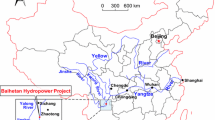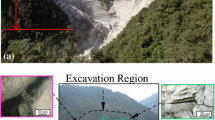Abstract
A state-of-the-art microseismic monitoring system has been implemented at the left bank slope of the Jinping first stage hydropower station since June 2009. The main objectives are to ensure slope safety under continuous excavation at the left slope, and, very recently, the safety of the concrete arch dam. The safety of the excavated slope is investigated through the development of fast and accurate real-time event location techniques aimed at assessing the evolution and migration of the seismic activity, as well as through the development of prediction capabilities for rock slope instability. Myriads of seismic events at the slope have been recorded by the microseismic monitoring system. Regions of damaged rock mass have been identified and delineated on the basis of the tempo-spatial distribution analysis of microseismic activity during the periods of excavation and consolidation grouting. However, how to effectively utilize the abundant microseismic data in order to quantify the stability of the slope remains a challenge. In this paper, a rock mass damage evolutional model based on microseismic data is proposed, combined with a 3D finite element method (FEM) model for feedback analysis of the left bank slope stability. The model elements with microseismic damage are interrogated and the deteriorated mechanical parameters determined accordingly. The relationship between microseismic activities induced by rock mass damage during slope instability, strength degradation, and dynamic instability of the slope are explored, and the slope stability is quantitatively evaluated. The results indicate that a constitutive relation considering microseismic damage is concordant with the simulation results and the influence of rock mass damage can be allowed for its feedback analysis of 3D slope stability. In addition, the safety coefficient of the rock slope considering microseismic damage is reduced by a value of 0.11, in comparison to the virgin rock slope model. Our results demonstrate that microseismic activity induced by construction disturbance only slightly affects the stability of the slope. The proposed feedback analysis technique provides a novel method for dynamically assessing rock slope stability and can be used to assess the slope stability of other similar rock slopes.

















Similar content being viewed by others
References
Boore DM, Boatwright J (1984) Average body-wave radiation coefficients. Bull Seismol Soc Am 74:1615–1621
Cai M, Kaiser PK, Martin CD (1998) A tensile model for the interpretation of microseismic events near underground openings. Pure Appl Geoph 153:67–92
Cai M, Kaiser PK, Martin CD (2001) Quantification of rock mass damage in underground excavations from microseismic event monitoring. Int J Rock Mech Min Sci 38:1135–1145
Cai M, Morioka H, Kaiser PK, Tasaka Y, Kurose H, Minami M, Maejima T (2007) Back-analysis of rock mass strength parameters using AE monitoring data. Int J Rock Mech Min Sci 44:538–549
Chen SH, Chen SF, Yang QG (2001) Feedback analysis of the rock slope of the Three Gorges project shiplock. Chin J Rock Mech Eng 20(5):619–626 (in Chinese)
Chen GQ, Feng XT, Jing Q, Li SJ, Xiang TB (2010) Study of dynamic early warning method of surrounding rock deformation monitoring for large underground powerhouse considering rock degradation. Rock Soil Mech 31(9):3012–3018 (in Chinese)
Deng JH, Lee CF (2001) Displacement back analysis for a steep slope at the Three Gorges Project site. Int J Rock Mech Min Sci 38(2):259–268
ESG Solutions (2006) ESG solutions: user’s guide. ESG Solutions, Kingston
Fang Z, Harrison JP (2001) A mechanical degradation index for rock. Int J Rock Mech Min Sci 38(8):1193–1199
Feng XT, Zhou H, Li SJ, Sheng Q, Jiang Q (2008) System of intelligent evaluation and prediction in space-time for safety of rock engineering under hazardous environment. Chin J Rock Mech Eng 27(9):1741–1756 (in Chinese)
Ge MC (2005) Efficient mine microseismic monitoring. Int J Coal Geol 64(1–2):44–56
Gibowicz SJ, Kijko A (1994) An introduction to mining seismology, 1st edn. Academic Press, San Diego, 396 pp
Gibowicz SJ, Young RP, Talebi S, Rawlence DJ (1991) Source parameters of seismic events at the Underground Research Laboratory in Manitoba, Canada: scaling relations for events with moment magnitude smaller than −2. Bull Seismol Soc Am 81:1157–1182
Gutenberg B, Richter CF (1956) Magnitude and energy of earthquakes. Ann Geo 9:1–15
Hanks TC, Kanamori H (1979) A moment magnitude scale. J Geohpys Res 84:2348–2350
Hirata A, Kameoka Y, Hirano T (2007) Safety management based on detection of possible rock bursts by AE monitoring during tunnel excavation. Rock Mech Rock Eng 40(6):563–576
Huang RQ (2008) Geodynamical process and stability control of high rock slope development. Chin J Rock Mech Eng 27(8):1525–1544 (in Chinese)
Hudyma MR (2008) Analysis and interpretation of clusters of seismic events in mines. Unpublished PhD thesis, University of Western Australia, Perth, Australia, 66 pp
Itasca Consulting Group, Inc. (2005) User’s manual of FLAC3D. Itasca Consulting Group Inc., Minneapolis
Jiang QH, Wang XH, Feng DX, Feng SR (2003) Slope3D—a three-dimensional limit equilibrium analysis software for slope stability and its application. Chin J Rock Mech Eng 22(7):1121–1125 (in Chinese)
Jing L (2003) A review of techniques, advances and outstanding issues in numerical modelling for rock mechanics and rock engineering. Int J Rock Mech Min Sci 40:283–353
Kachanov LM (1986) Introduction to continuum damage mechanics. Martinus Nijhoff Publishers, Dordrecht
Kaiser PK, Maloney S, Vasak P, Wang G (2009) Seismic excavation hazard evaluation in underground construction. In: Proceedings of the 7th international symposium on rockburst and seismicity in mines, controlling seismic hazard and sustainable development of deep mines (RaSiM7), Dalian, China, August 2009. Rinton Press, New York, p 1–26
Lemaitre J, Chaboche J-L, Shrivastava B (1994) Mechanics of solid materials. Cambridge University Press, Cambridge
Li T, Cai MF, Cai M (2007) A review of mining-induced seismicity in China. Int J Rock Mech Min Sci 44:1149–1171
Li LC, Tang CA, Zhu WC, Liang ZZ (2009) Numerical analysis of slope stability based on the gravity increase method. Comput Geotech 36:1246–1258
Liang ZZ, Xing H, Wang SY, Williams DJ, Tang CA (2012) A three-dimensional numerical investigation of the fracture of rock specimens containing a pre-existing surface flaw. Comput Geotech 45:19–33
Liu ZB, Xu WY, Jin HY, Liu DW (2010) Study on warning criterion for rock slope on left bank of Jinping No. 1 hydropower station. J Hydraul Eng 41(1):101–107 (in Chinese)
Lu C-P, Dou L-M, Liu H, Liu H-S, Liu B, Du B-B (2012) Case study on microseismic effect of coal and gas outburst process. Int J Rock Mech Min Sci 53:101–110
Madariaga R (1976) Dynamics of an expanding circular fault. Bull Seismol Soc Am 66:639–666
McGarr A (1976) Seismic moments and volume changes. J Geophys Res 81(8):1487–1494
Qi SW, Wu FQ, Yan FZ, Lan HX (2004) Mechanism of deep cracks in the left bank slope of Jinping first stage hydropower station. Eng Geol 73(1–2):129–144
Qian JH, Yin ZZ (1996) Theory and calculation of soil engineering. China Water Power Press, Beijing, pp 302–343 (in Chinese)
Shi GH (1996) Numerical manifold method. In: Proceedings of IFDDA’96. TSI Press, Berkeley, California, USA, p 52–204
Snoke JA (1987) Stable determination of (Brune) stress drops. Bull Seismol Soc Am 77:530–538
Solecki R, Conant RJ (2003) Advanced mechanics of materials. Oxford University Press, London
Song SW, Xiang BY, Yang JX, Feng XM (2010) Stability analysis and reinforcement design of high and steep slopes with complex geology abutment of Jinping I hydropower station. Chin J Rock Mech Eng 29(3):442–458 (in Chinese)
Stead D, Eberhardt E, Coggan JS (2006) Developments in the characterization of complex rock slope deformation and failure using numerical modelling techniques. Eng Geol 83:217–235
Steffler ED, Epstein JS, Conley EG (2003) Energy partitioning for a crack under remote shear and compression. Int J Fract 120:563–580
Sujatha V, Kishen C (2003) Energy release rate due to friction at bimaterial interface in dams. J Eng Mech 129:793–800
Tang CA (1997) Numerical simulation of progressive rock failure and associated seismicity. Int J Rock Mech Min Sci 34:249–261
Tang LZ (2009) Study on monitoring and prediction of seismicity and rockburst in a deep mine. PhD thesis (in Chinese), Central South University, Changsha, China
Tang CA, Kaiser PK (1998) Numerical simulation of cumulative damage and seismic energy release during brittle rock failure—part I: fundamentals. Int J Rock Mech Min Sci 35:113–121
Tang CA, Liu H, Lee PKK, Tsui Y, Tham LG (2000) Numerical tests on micro-macro relationship of rock failure under uniaxial compression, part I: effect of heterogeneity. Int J Rock Mech Min Sci 37:555–569
Tang CA, Wang JM, Zhang JJ (2011) Preliminary engineering application of microseismic monitoring technique to rockburst prediction in tunneling of Jinping II project. J Rock Mech Geotech Eng 2(3):193–208
Trifu CI, Shumila V (2010) Microseismic monitoring of a controlled collapse in field II at Ocnele Mari, Romania. Pure Appl Geophys 167(1–2):27–42
Wang RL, Li JL, Liu J, Huang QF (2007) Three-dimensional stability analysis of dam abutment high slope dynamic behaviors considering rock mass unloading. Chin J Rock Mech Eng 26(Suppl 1):3515–3521 (in Chinese)
Xie HP, Ju Y, Li LY (2005) Criteria for strength and structural failure of rocks based on energy dissipation and energy release principles. Chin J Rock Mech Eng 24(17):3003–3010 (in Chinese)
Xie HP, Ju Y, Li LY, Peng RD (2008) Energy mechanism of deformation and failure of rock masses. Chin J Rock Mech Eng 27(9):1729–1739 (in Chinese)
Xie HP, Li LY, Ju Y, Peng RD, Yang YM (2011) Energy analysis for damage and catastrophic failure of rocks. Sci China Tech Sci 54(Suppl 1):199–209
Xu NW (2011) Study on microseismic monitoring and stability analysis of high steep rock slope. PhD thesis (in Chinese), Dalian University of Technology, Dalian, China, 145 pp
Xu NW, Tang CA, Li LC, Zhou Z, Sha C, Liang ZZ, Yang JY (2011) Microseismic monitoring and stability analysis of the left bank slope in Jinping first stage hydropower station in southwestern China. Int J Rock Mech Min Sci 48:950–963
Xu NW, Tang CA, Li H, Dai F, Ma K, Shao JD, Wu JC (2012) Excavation-induced microseismicity: microseismic monitoring and numerical simulation. J Zhejiang Univ SCI A 13(6):445–460
Young RP, Collins DS (2001) Seismic studies of rock fracture at the Underground Research Laboratory, Canada. Int J Rock Mech Min Sci 38:787–799
Young RP, Collins DS, Reyes-Montes JM, Baker C (2004) Quantification and interpretation of seismicity. Int J Rock Mech Min Sci 41:1317–1327
Zhang LJ, Hu ZJ, Lei J (2005) Application of FLAC-3D to stability analysis of slope rock mass. Rock Soil Mech 26(S1):61–65 (in Chinese)
Zhang GX, Zhao Y, Peng XC (2007) Simulation of toppling failure of rock slope by numerical manifold method considering fracture of rock bridges. Chin J Rock Mech Eng 26(9):1773–1780 (in Chinese)
Zhang BH, Deng JH, Gao MZ, Zhou ZH, Wu JC, Wu SH (2012) Safety evaluation research based on microseismic monitoring in underground powerhouse of hydropower station. Chin J Rock Mech Eng 31(5):937–9444 (in Chinese)
Zheng H, Sun GH, Liu DF (2009) A practical procedure for searching critical slip surfaces of slopes based on the strength reduction technique. Comput Geotech 36:1–5
Zhou HM, Sheng Q, Li WS, Xiao GQ (2004) Excavation-disturbed zone and weaken degree of mechanical properties for rockmass of TGP shiplock slope. Chin J Rock Mech Eng 23(7):1078–1081 (in Chinese)
Zhou WY, Lin P, Yang Q, Yang RQ, Zhou Z (2008) Experimental research on stability of Jinping high slope with three-dimensional geomechanical model. Chin J Rock Mech Eng 27(5):893–901 (in Chinese)
Acknowledgments
The authors are grateful for the financial support from the National Natural Science Foundation of China (No. 51209127), the National Basic Research Program of China (973 Program, No. 2011CB013503), the Excellent Young Scholar Plan of Sichuan University (No. 2012SCU04A07), the Young Teachers’ Plan of Sichuan University (No. 2012SCU11062), and the innovative research team of Sichuan province (No. 13TD0039). The authors are thankful to the two anonymous referees and Professor Giovanni Barla for their valuable comments and suggestions devoted to improving the quality of our manuscript.
Author information
Authors and Affiliations
Corresponding author
Rights and permissions
About this article
Cite this article
Xu, N.W., Dai, F., Liang, Z.Z. et al. The Dynamic Evaluation of Rock Slope Stability Considering the Effects of Microseismic Damage. Rock Mech Rock Eng 47, 621–642 (2014). https://doi.org/10.1007/s00603-013-0432-5
Received:
Accepted:
Published:
Issue Date:
DOI: https://doi.org/10.1007/s00603-013-0432-5




